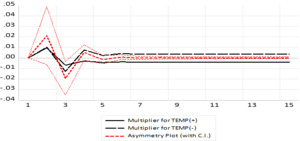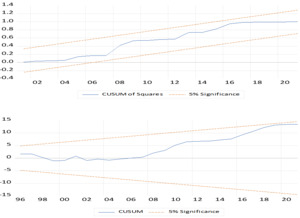I. Introduction
Recently, numerous people have secured a reliable energy supply due to its indispensable role in modern human life, industrial processes, transportation, communication, and overall economic advancement. Ensuring the availability, accessibility, affordability, and sustainability of energy is currently a major policy goal globally (Arndt, 2023). Energy security constitutes a nation’s ability to meet its energy needs without disruption. Consequently, diverse and reliable energy supply, good energy demand management, and appropriate responses to changes in the energy market are needed (Adhikari & Agrawal, 2023). However, a significant environmental challenge looms large. This century has witnessed climate change, primarily driven by the excessive release of greenhouse gases like carbon monoxide because human activities surpass nature’s protective capacity. Climate change negatively impacts energy production and transportation. For example, extreme weather events, such as hurricanes and floods, damage energy infrastructure and disrupt energy production. Additionally, climate change causes a decline in water resources, which are essential for energy production (Chen et al., 2023). Apart from natural disasters, some extensive effects include delayed energy imports, disrupted fuel deliveries, and destroyed biofuel crops. These climatic upheavals also directly contribute to power outages and interruptions, often damaging social infrastructure and consumer equipment. Overall, climate change deters countries from meeting their energy needs reliably and affordably, as it affects energy demand and supply (Gupta & Saini, 2023).
This study promotes the understanding of the complex interplay between energy security and climate change. The nonlinear autoregressive distributed lag (NARDL) model addressed the intricate nature of climate change effects. This model captured the dual extremes of climate change, such as excessive rainfall leading to floods and reduced rainfall resulting in drought. The NARDL model effectively categorized these effects into positive and negative components, unveiling the nonlinear dynamics. Notably, this study extended the conventional measurement of energy security, which was originally defined by Zhao and Deng (2021) as the ratio of energy import to energy use. Here, energy security encompasses energy import and energy depletion and captures the vulnerability arising from the loss of domestic energy production capacity.
This study found a statistically significant long-term relationship between climate change and energy security; thus, the NARDL approach was appropriate for analysis. From the short-run NARDL model, an increase in climate change negatively affects energy security, while a decrease favourably impacts climate change. Based on the long-run NARDL model, climate change has an adverse influence on energy security, aligning with the consensus that climate change poses a significant risk over time. The study contributes to the climate change and energy security literature by offering empirical evidence of a significant long-term relationship between the two factors. Additionally, it validates the use of the NARDL approach. Furthermore, the NARDL represents a methodological advancement that provides insight into the short- and long-term impact of climate change on energy security. The approach also demonstrated the detrimental effect of climate change escalation and the positive influence of climate change reduction.
This study is structured as follows: Section II delves into the discussion on data and methodology, section III delves into the empirical results, and section IV presents policy recommendations based on the understanding derived from this study.
II. Data and Methodology
A. Data
This study used data spanning 1970 to 2022 from the World Development Indicator database and the National Centre for Environmental Information. The variables in this study comprise energy security, captured as the ratio of energy import to energy use:
\[\small{EnergySecurity = \left( \frac{Energy{Im}port}{EnergyUse} \right)}\tag{1}\]
However, this study extended energy security to incorporate energy depletion by dividing the sum of energy import and depletion by energy use:
\[\small{Energy\ security\ = \left( \frac{Energy{Im}port + EnergyDepletion}{EnergyUse} \right)}\tag{2}\]
Energy depletion was included because it represents a reduction in a nation’s ability to domestically produce energy, which is an energy security challenge. This holistic measure improves energy security assessment; this can aid policymakers in addressing import dependence and domestic production capacity for effective energy policy planning. This study employed other variables, namely temperature anomalies as a surrogate for climate change (Brisson et al., 2023; Kharin et al., 2023), GDP growth rate, Gross Fixed Capital Formation (GFCF) in Billion US dollars, Industrial Value added in Billion US dollars, and openness to international trade. These were the control variables that were necessary in regression analysis to improve the accuracy, robustness, and validity of the model.
B. Methodology
This study aimed to scrutinize the influence of climate change on energy security. A NARDL model was employed. This technique captures long- and short-run asymmetries (Pesaran et al., 1999). Notably, this approach introduces nonlinearity into the traditional ARDL method by integrating partial sum dynamic adjustments (Shin et al., 2009). The versatility of the NARDL approach lies in its applicability whether the involved variables exhibit unit roots or are covariance stationary. Moreover, the technique accommodates endogeneity and serial correlation and permits evaluations of potentially asymmetric (i.e., nonlinear) inflation adjustments in response to fluctuations in other variables. This allows positive and negative shocks within the framework to be evaluated. The model for this study is represented by the following equation:
\[\small{\begin{aligned} \Delta Energy_{t} &= \beta_{0} + \beta_{1}Energy_{t - 1} + \beta_{2}Temp_{t - 1}^{+}\\ & \quad + \beta_{3}Temp_{t - 1}^{-} + \beta_{4}GDPGrowth_{t - 1}\\ & \quad + \beta_{5}GFCF_{t - 1} + \beta_{6}INDV_{t - 1}\\ & \quad + \beta_{7}Openness_{t - 1}\\ & \quad + \sum_{i = 1}^{P - 1}{\rho_{1i}\Delta Energy_{t - i} + \sum_{i = 0}^{q - 1}{\rho_{2i}\Delta}}Temp_{t - i}^{+}\\ & \quad + \sum_{i = 0}^{q - 1}{\rho_{3i}\Delta}Temp_{t - i}^{-} + \sum_{i = 0}^{q - 1}\rho_{4i}\Delta GDPGrowth_{t - i}\\ & \quad + \sum_{i = 0}^{q - 1}{\rho_{5i}\Delta}GFCF_{t - i} + \sum_{i = 0}^{q - 1}{\rho_{6i}\Delta}INDV_{t - i}\\ & \quad + \sum_{i = 0}^{q - 1}\rho_{7i}\Delta Openness_{t - i} + \mu_{t} \end{aligned}}\tag{3}\]
where the variable Energy signifies energy security, with larger values indicating lower energy security. Temp refers to temperature anomalies, serving as a proxy for climate change. Temp+ and Temp- capture the positive and negative components of temperature anomalies, respectively. GDP-Growth represents GDP growth rate, GFCF signifies Gross Fixed Capital Formation in Billion US dollars, INDV represents Industrial Value added in Billion US dollars, and Openness denotes the degree of openness to international trade. The error term is represented by µt.
III. Empirical Results
Table 1 presents the statistical characteristics of the data. The mean values reflect the averages over the study period. Notably, the mean of the ENERGY variable indicates negative values, suggesting an improvement in energy security over the study period; lower energy security index values correspond to improvement. The mean of the TEMP variable, representing temperature changes as a proxy for climate change, was positive, indicating a rising global temperature trend. The standard deviation values suggest a moderate dispersion around the mean. The Augmented Dickey-Fuller (ADF) and Philip-Perron (PP) test statistics reveal that ENERGY and GFCF are stationary at level, while other variables are stationary at first difference. This stationarity pattern is appropriate for using a NARDL model.
Furthermore, a prerequisite for employing the NARDL technique is the existence of a long-run relationship. To assess this requirement, the study conducted a bound cointegration test (see Table 2). The test results indicate the presence of a long-run relationship between climate change and energy security, hence the use of the NARDL model. Delving into the short-run NARDL results, it was evident that an escalation in climate change, represented by the positive index of temperature (TEMP_POS), adversely affects energy security. Conversely, a reduction in climate change, as captured by the negative index of temperature (TEMP_NEG), appears to have a favourable impact on energy security. This finding aligns with the conclusions drawn by Zhao and Deng (2021).
Table 3 presents both the long-run and short-run estimated coefficients. From the long-run perspective, the NARDL analysis reveals that climate change exerts a detrimental influence on energy security. This aligns with the broader consensus that climate change poses a significant risk to energy security over the long term. In the short run, the constant term (C) negatively impacts energy security. Positive temperature anomalies (TEMP_POS) exhibit a significant positive effect, while negative temperature anomalies (TEMP_NEG) display a smaller but noteworthy positive influence on energy security.
Additionally, GDP growth rate, openness to international trade, and INDV seemed to impact energy security in the short run, although the significance levels varied. In contrast, GFCF demonstrated a negligible impact. This study’s findings reinforce prior studies’ detected connection between climate change and energy security. The short-run analysis reveals that heightened temperature anomalies negatively impact energy security, consistent with Zhao and Deng’s (2021) study, while decreasing climate change has a beneficial effect on energy security, which aligns with Gupta and Saini’s (2023) study. In the long run, the study’s identification of a consistently adverse effect of climate change on energy security supports existing literature. This study expands the criteria used to measure energy security by including energy imports and depletion (Adhikari & Agrawal, 2023). By harmonizing empirical findings and theoretical concepts, this study underscores the imperative of addressing climate change to fortify global energy security.
Overall, the model demonstrates a satisfactory explanatory power, as reflected in the Adjusted R2 and the significant F-statistic. The study employed the Cumulative Sum of Squares (CUSUMSQ) test to confirm the stability of estimated coefficients. Figure 2 displays the CUSUMSQ results, demonstrating that the plot falls within stable boundaries, affirming the model’s reliability. Moreover, as indicated in figure 1, the NARDL multiplier highlights the non-linear connection between climate change and energy security. These methodological assessments enhance the credibility of the study’s conclusions and reinforces the identified relationships.
IV. Conclusion
In summary, this study employed the NARDL model to examine the relationship between climate change and energy security. The findings reveal that climate change exerts a significant influence on energy security in the short and long run. Increased temperature anomalies have a detrimental impact on energy security, while mitigating climate change through reductions in temperature anomalies can lead to positive outcomes. Importantly, the long-term analysis underscores the persistent negative effect of climate change on energy security, highlighting the urgent need for proactive measures.
Based on these insights, this study recommended that policies encompass a dual approach—mitigation and adaptation—to reduce emissions and enhance resilience against climate-induced disruptions. Additionally, adopting renewable energy sources can mitigate the adverse effects of climate change and diversify energy supply. Finally, integrated policy frameworks that synergistically address climate change and energy security can yield multifaceted benefits, including improved energy efficiency and reduced emissions.




